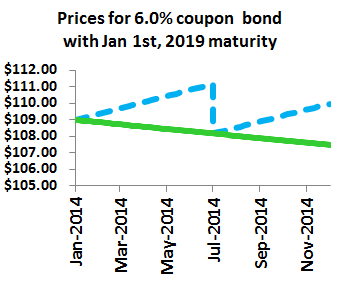Fran
Administrator
AIMs: Differentiate between “clean” and “dirty” bond pricing and explain the implications of accrued interest with respect to bond pricing. Describe the common day-count conventions used in bond pricing.
Questions:
311.1. An investor purchases $10,000 face amount of the U.S. Treasury 2 7/8 (coupon rate = 2.875%) of August 15, 2019, for settlement on June 1st, 2014. The last coupon paid on February 15, 2014 and the next coupon pays on August 15, 2014. If the invoice price is $10,043.19, which is nearest to the bond's quoted price at settlement?
a. $9,887.25
b. $9,959.00
c. $10,033.67
d. $10,112.93
311.2. An investor buys $10,000 face amount of the U.S. Treasury 6 1/2 (coupon rate = 6.50%) of August 15, 2017, for settlement on July 1st, 2014. The last coupon paid on February 15, 2014 and the next coupon pays on August 15, 2014. The bond's yield to maturity happens to be 4.00%. What is nearest to the bond's quoted price at settlement? (this adds a level of difficulty by not giving you the invoice price)
a. $9,338.48
b. $9,904.15
c. $10,095.07
d. $10,726.83
311.3. The following chart plots two prices for a 6.0% coupon bond that matures on January 1st, 2019:

Each of the following statements is necessarily true EXCEPT which is not?
a. The dotted blue line is the dirty (aka, full, invoice) price
b. The solid green line is the clean (aka, flat, quoted) price
c. The solid green line represents the money that changes hands in a buy/sell transaction
d. This bond's yield must be less than 6.0% such that the solid green line slopes downward throughout
Answers:
Questions:
311.1. An investor purchases $10,000 face amount of the U.S. Treasury 2 7/8 (coupon rate = 2.875%) of August 15, 2019, for settlement on June 1st, 2014. The last coupon paid on February 15, 2014 and the next coupon pays on August 15, 2014. If the invoice price is $10,043.19, which is nearest to the bond's quoted price at settlement?
a. $9,887.25
b. $9,959.00
c. $10,033.67
d. $10,112.93
311.2. An investor buys $10,000 face amount of the U.S. Treasury 6 1/2 (coupon rate = 6.50%) of August 15, 2017, for settlement on July 1st, 2014. The last coupon paid on February 15, 2014 and the next coupon pays on August 15, 2014. The bond's yield to maturity happens to be 4.00%. What is nearest to the bond's quoted price at settlement? (this adds a level of difficulty by not giving you the invoice price)
a. $9,338.48
b. $9,904.15
c. $10,095.07
d. $10,726.83
311.3. The following chart plots two prices for a 6.0% coupon bond that matures on January 1st, 2019:

Each of the following statements is necessarily true EXCEPT which is not?
a. The dotted blue line is the dirty (aka, full, invoice) price
b. The solid green line is the clean (aka, flat, quoted) price
c. The solid green line represents the money that changes hands in a buy/sell transaction
d. This bond's yield must be less than 6.0% such that the solid green line slopes downward throughout
Answers:
